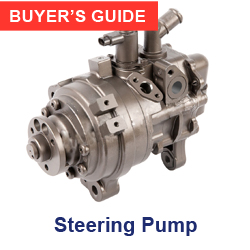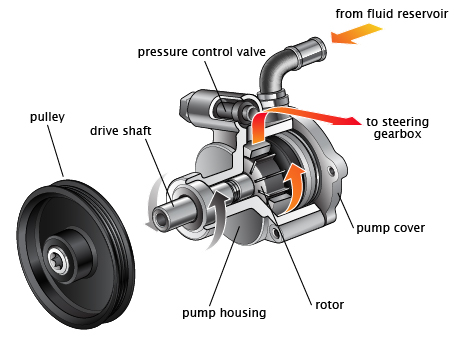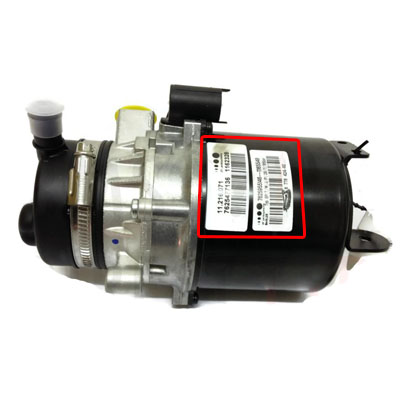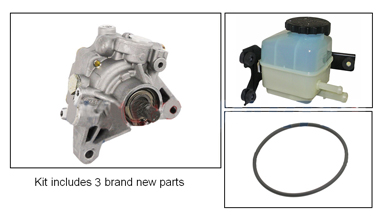How to Buy a Steering Pump

A power steering pump provides the required hydraulic pressure to steer your automobile with a minimal effort on the steering wheel. Knowing about the working of a steering pump and its possible causes of failure and their symptoms can help you in addressing the problems at an earlier stage, and prevent costly repairs for the pump in the future. This buyer's guide is designed to provide basic information about the functionality of the steering pump, indications of a defective pump and repair of a faulty pump.
Function/Working of a Power Steering Pump
The power steering pump is driven by the engine's crankshaft via a belt-pulley mechanism. The pump is usually located in the front of the engine, adjacent to the alternator or AC compressor. The steering pump compresses the hydraulic fluid at a rate directly proportional to the speed of the engine. The pump is built as such to provide the required pressure in different engine conditions such as idling or running at high speeds.

When the engine is running, the power steering pump's rotor, which is connected to the pulley, turns. The spinning rotor pressurizes the fluid and delivers it to the steering gearbox. The pulley has open grooves on its sides that mesh precisely with the rubber belt. A rotary valve, torsion bar and a spool valve assembly are other components involved in directing the steering fluid from the pump in the appropriate direction based on the rotation of the steering wheel.
Types of Power Steering Pump All steering pumps are equipped with a rotor; the designs of the rotor's fins are what determines their type. Based on the design of the rotor's fins, the classification is as follows: Rotary Vane Steering Pump: These are the most common kinds of pumps used in automobiles. The vanes are mounted on the rotor such that they touch the housing wall. The power steering fluid is caught between the vanes, the rotor and the housing wall. Roller Steering Pump: Roller steering pumps, as the name signifies, have rollers that ride along the inner contour of the pump. The rotor has wide V-shaped grooves cut into its sides. The rollers are pushed to the outer edge of the pump's housing by means of centrifugal force. This action traps the power steering fluid and compresses it. Slipper Power Steering Pump: These types of power steering pumps contain springs attached to the rotor. The springs have slippers fitted on their tops and the slippers are in continuous contact with the pump's wall. The pressure build-up inside the pump causes the fluid to be compressed. |
What problems could affect your power steering pump?
|
Symptoms of a Faulty Steering Pump
|
Tips to Maintain your Steering Pump Check the belt tension on a regular basis. A belt that is too loose may whip off the pulley. If it is too tight, it can cause the belt to wear prematurely. Check the level of the power steering fluid at the interval specified in the owner's manual. |
Things to Note while Replacing the Pump
|
Finding Your Power Steering Pump's OEM Part Number If for any reason you cannot find your power steering pump by entering your vehicle's year, make and model, you can find it by its Original Equipment Manufacturer (OEM) number. The OEM part number can be found directly on the part itself. You can also call a dealership with your VIN, and they will provide you with the OEM part number. You can give one of our car specialists a call at 1-888-907-7225 for further assistance in purchasing your steering pump. |
 |
Power Steering Pump Kit While replacing the power steering pump, it is often recommended to replace its associated components such as the reservoir, gasket and fan, as well. At BuyAutoParts.com, you can find different combinations of the parts related to the steering pump in a single kit. Buying two or more parts together as a kit will get you a huge discount!  BuyAutoParts.com also sells a line of power steering parts such as the |
Get to know about BuyAutoParts.com's shipping and warranty policies. |
Frequently Asked Questions |
How to replace the power steering pump? |
1. Drain the system and disconnect the hoses. 2. Remove the power steering pulley. 3. Unbolt the power steering pump. 4. Replace the old pump with the new one. 5. Attach the feed line, the pulley and the belt. 6. Flush the new pump and connect the return line. Note: Have a catch pan to collect the hydraulic fluid that drains out while disconnecting the hoses. |
Can I install the steering pump myself? |
You can install your steering pump yourself if you are comfortable doing labor intensive repairs. It is better to refer to your owner's manual to find the exact location of the pump and precautionary measures to be taken during installation. |
How to check a new steering pump right away after installation? |
After replacing the pump, it is a good practice to check it once for proper functioning. 1. Run the engine for a few minutes. 2. Check the level of fluid in the pump using a dipstick. 3. Move your steering wheel right and left to assess if there is any resistance in the movement. If the above steps turn out well, the installation is perfect. |
How to check and add power steering fluid? |
1. Locate the reservoir cylinder.. 2. Check the level of steering fluid using a dipstick. 3. Add the power steering fluid carefully to avoid overfilling. Note: It is a better to under-fill the reservoir than overfilling it, as the fluid expands when it gets heated. |
My power steering fluid is brown/black. What does it mean? |
A brown-or black-colored steering fluid indicates the presence of rubber deposits in it. This is due to worn-out connecting hoses or seals. The standard color of the steering fluid is either amber or pinkish and it should be visibly clear. |
Find more articles on power steering in this link: REPAIR STEERING


